The amazing Dionaea flower or Venus flytrap (Dionaea muscipula) is one of the most famous carnivorous plants with a unique trap, and presents only one species in nature. Dionaea muscipula grows in one small region of the world - along the east coast of the United States in a small part of North Carolina and Southern California.
The flower was discovered in the late 1760s and named after the Greek goddess Dionea, which explains the scientific name of the genus Dionaea. The species name "muscipula" is translated from Latin as a mousetrap.
How to care

Care for Venus flytrap in the home is not at all difficult. It grows well in poor soils with good drainage, so for transplanting you will need one-third of sand or perlite and two-thirds of sphagnum moss, which provides good drainage and moisture. Do not add lime to the soil and never fertilize the plant.
Shine
Dionea prefers bright diffused lighting at least 4 hours a day and does not like shade. Just do not put the pot in direct sunlight in the summer, especially if your flower lives in the paludarium. The soil in such conditions can become so hot that it will quickly lead to the death of your pet. In room conditions it grows well on the eastern and western windows or under artificial luminescent light. If the color of Dionea's traps became dull, and the leaves thin and stretched out, then the flower does not receive enough sunlight.
Water
Never water a Venus flytrap with tap or bottled water, as it contains too many additional compounds that can be harmful to the plant. Ideal - rainwater, distilled or filtered water.
Keep track of the soil and air humidity, but do not let the water stagnate in the pot. Choose a container with drainage holes. Not superfluous will be expanded clay, which is poured in a small layer to the bottom of the pot. Good air circulation is also important. You can pour water into the pan to a height of 2 cm - the flower itself will regulate the flow of moisture.
Feeding
Although predator flowers can catch and digest insects, and sometimes small animals, they get food and energy from the sun. These are plants, which means they can carry out photosynthesis. Sunlight for several hours a day is more important to them than feeding flies and mosquitoes.
At home, the Venus flytrap can be fed no more than once in 7-10 days and only one or two traps. A good nutritional cycle for optimal growth is every two weeks.
The prey must be alive so that the hairs can move and irritate - triggers that are extremely sensitive to movement. As soon as the hairs touch each other twice, the trap will work and will be closed for several days, until the prey is completely digested, leaving one chitinous shell. Watch out for insect size. They must fit freely in the traps so that the flaps can close tightly and no infection gets there.
When growing Dionea in the paludarium, the easiest method of feeding is the release of small midges or mosquitoes inside the space. The plant itself will decide when to "have lunch". If the sash will often work, the trap dies, as the flower requires a large amount of energy for this action. In this case, it should be carefully cut so that new shoots can develop.
Do not feed Dionea if:
Weak or sick.
Grew in too wet conditions and lack of sun.
It was recently transplanted and the roots have not yet adapted to the new soil.
She has experienced stress from any cause, including sunburn or excessive fertilization of the soil.
In addition, flycatchers, as a rule, almost never eat insects during their annual winter dormancy.
Although the plant is carnivorous, it can go without a live meal for a long period of time — a month or two.
Winter rest
In order for the Venus flytrap at home to survive in the long term, it must have a rest period that lasts from three to five months. Without rest, the flowers weaken and die.
A sleeping flycatcher is not very attractive looking. In fact, most people who do not know what a plant looks like in a given period may think that it is dying. Some simply throw the flower away, mistakenly believing that it has died, since almost all the leaves turn brown and die, and the growth almost stops.
The typical rest period lasts from November to February. During this time, your pet still needs light, but for a shorter time. Watering is also reduced, but does not allow the soil to dry out.
The air temperature should be lowered to 8 - 5 degrees. Dead leaves and traps during the entire period of hibernation are pruned.
Around the end of February, when the day becomes longer, the growing season begins. However, the active growth of the flower will begin only from the end of May.
Transfer
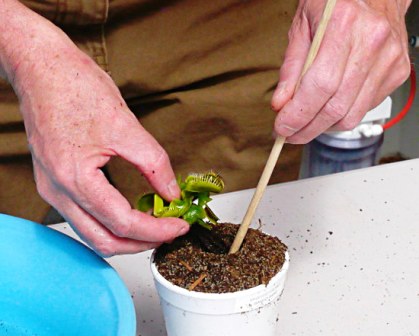
It is possible to replant Dionea at any time of the year, but it is better to do it in the spring during the period of active growth. The pot should be deep and narrow, as the roots of the flower grow deep down and can reach a length of 20 cm. Before starting the process, make sure that the nutrient medium used is slightly damp. The root system of the flycatcher is quite fragile, so be careful. When transplanting, you can immediately divide the mother plant into several children and plant them in separate pots.
Soaking the roots in water for a few minutes before planting helps remove old soil residue and promotes hydration. After the procedure, lift the leaves above the soil and wash them with a spray bottle. It takes 5 weeks for the plant to adapt to the new soil. Temporarily increase watering and do not put the pot on a bright light.
Breeding
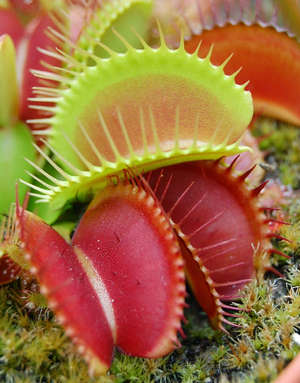
In spring, the plant blooms with beautiful white flowers, which, after pollination by hand, produce seeds. About a month later, tiny boxes are formed. The collected seeds are planted 3 months after pollination. They are sown in the prepared warm soil (sphagnum moss 70% and sand 30%) in a special greenhouse and sprout for 15-20 days. Keep track of the moisture of the earth, not allowing it to dry. When the seedlings grow, they are carefully transplanted 3-4 things in a separate container. It will take the seedlings about 3 years to grow to the size of an adult flycatcher.
Reproduction division maternal bush more simple. With age, when Dionea forms several points of growth, it is possible to begin its division. The fused roots are carefully cut, and young plants are planted in new pot.
Pests
Insectivorous pet is not often attacked by pests, but when they are, the results can be quite devastating. It is therefore useful and advisable to develop the habit of preventive treatments with insecticidal aerosols throughout the year.
Perhaps the most common pests are aphids, spider mites and mealybugs.
If the substrate is highly wetted, fungal diseases such as gray mold or black black fungus can develop. In this case, the flower is treated with a fungicide.
A very exotic plant called Venus flytrap is gaining popularity among flora lovers. Previously it was believed that such an insectivorous predator can grow only in the wild. But practice has shown that this amazing and beautiful flower tolerates care at home, which you will learn from this article.
A distinctive feature of this exotic wonder of nature, is expressed in the unique structure of the leaves in the form of a trap. Venus flytrap, like other members of the wild, has a second name - Dionea. Ostensibly there once existed the ancient Greek goddess Dionea, who promoted the formation of another name for the genus Dionaea. But the official name of this predatory plant was given in tribute to the Roman goddess Venus - the personification of love itself and flora.
Venus flytrap flower (Dionaea muscipula) has a small size and reaches no more than 20 cm in diameter. Bulbous stem growing from the base of the roots. The ground part of the stalks smoothly turns into rounded leaves-traps, equipped with long teeth to capture the insect. On average, these leaves can be from 4 to 7 pieces. The length of one leaf is about 7 cm, and the width is 2-3 cm.
The root system of the plant is small, as it refers to the grass vegetation. Breeders for variety bred some varieties of Venus flytrap. Such varieties as, big mouth and low diant have large oval trap maroon-green color. Variety red dragon received a bright purple color and rounded leaves-lobes.
Dionea blooms once a year in the spring, throwing out a long stalk. It is so long that the bees that pollinate it do not fall into its predatory paws. Flowering occurs in spring and summer. Plain white flowers in the amount of 5-10 are collected in one inflorescence, reaching about 4-5 cm in diameter. If the plant does not require seed ripening, then the inflorescence is removed to avoid wasting the strength and energy costs of the seedling.
The principle of catching insects
The slamming mechanism is based on six sensitive hairs located on both sides of the trap. These hairs serve as a trigger. When an insect hits a leaf, it hooks on these hairs, and the trap instantly closes. The rate at which the slamming process occurs is faster than blinking an eye.. The further the insect sneaks in, the more the trap flaps close.
After that, the plant produces a red juice, with which the Venus flytrap splits the insect for about 10 days. At the end of the process, the trap opens and the plant begins its “hunt” again.
Basic care requirements
In the wild, the flower of Venus flytrap grows mainly on the Atlantic coast of the United States. It is a humid and temperate climate that is ideal for plant growth. When caring for Venus flytrap, follow these rules.
Lighting
To grow a beautiful bush from a small stalk, it is enough to place a pot with a seedling on the south side of the home window. But in direct sunlight, the ground for Venus flytrap quickly dries out. Therefore, it is better to hide the pot in the shade. Sunlight is so important that it can temporarily replace fertilizing and watering. When there is insufficient light, the color of the traps becomes pale green and the leaves are elongated. Sometimes, additional light comes from fluorescent lights.
Important! Do not constantly rotate the flower pot 90 ° for the receipt of sunlight.
Watering plants
The main secret of how to grow Venus flytrap healthy and beautiful, is a regular watering. Excessive watering will lead to rotting of the root system and the ground part. Insufficient watering can destroy the plant. Therefore, care at home means the constant provision of soil moisture. Only such an approach will create the usual conditions and will contribute to the successful cultivation of Dionei. Water must be distilled or filtered. Liquid from bottles or from the tap is not suitable, because it contains harmful chemical compounds.
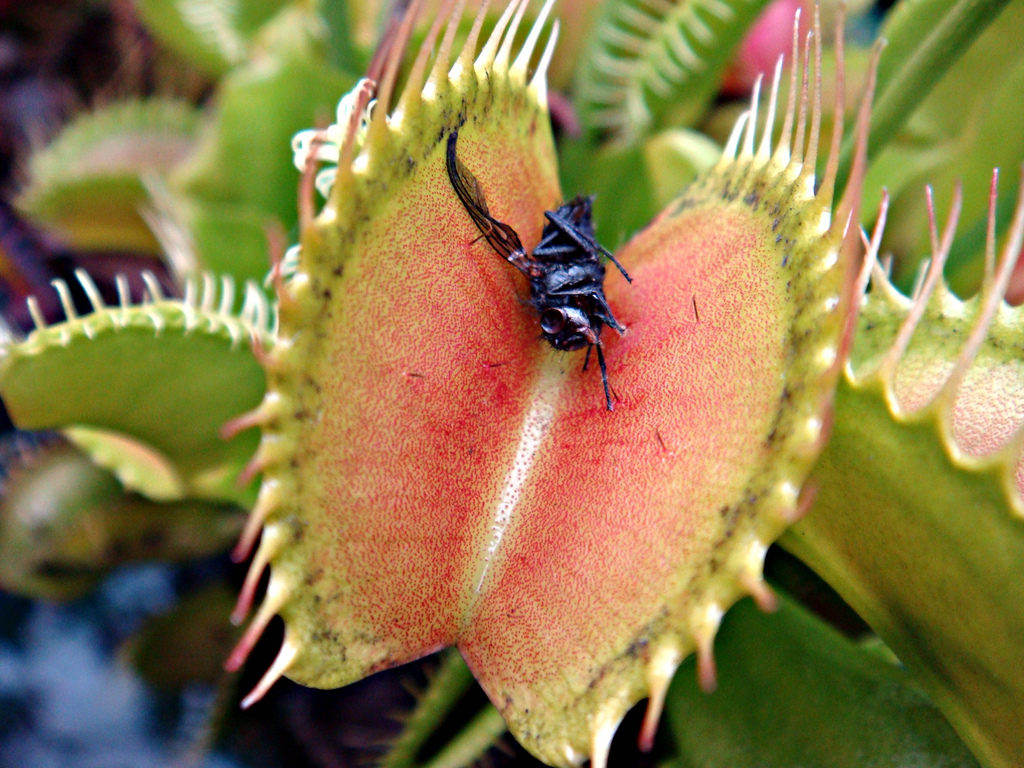
Wintering Venus Flytrap
Every winter, the Venus flytrap flower goes to rest. Stems gradually die off, leaving only the roots. At this time, the pot is placed in a refrigerator or cellar. The rest period lasts from the end of October to the end of February. The air temperature should be +5, + 10 ° C. During wintering, the flower can be watered1 once a month, despite the complete absence of greenery.
Top dressing by Venus flytrap
Dionea feeds exclusively on insects about 1 time in 10-14 days. Overfeeding can cause rot. Therefore, before caring for Venus flytrap, you need to familiarize yourself with the permissible insect species suitable for feeding. Insects must be small in size, otherwise the plant will not be able to digest them and the trap will rot. You can feed these insects:
- flies;
- mosquitoes;
- spiders;
- ants.
Insects that are forbidden to feed the plant:
- Beetles;
- Caterpillars;
- Motyle;
- Larvae;
- Worms.
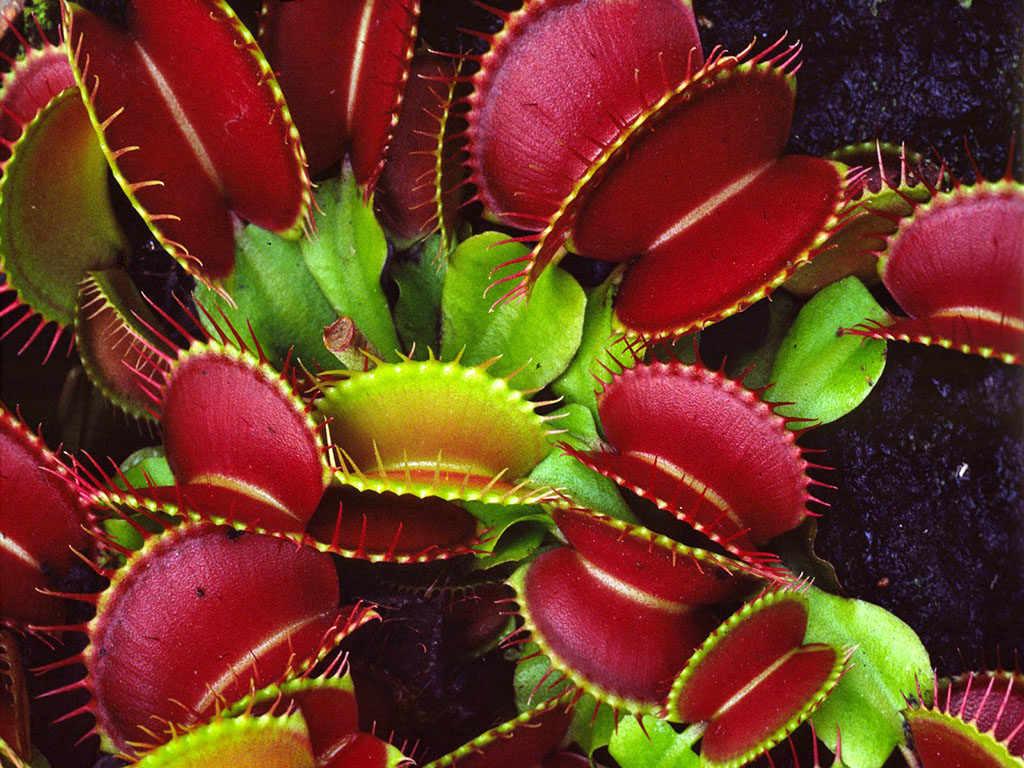
A weak and not strong plant cannot be often fed, otherwise it will not cope with digestion. Mineral supplements in water are prohibited. It usually grows in wetlands where there is a shortage of nitrogen. The synthesis of proteins, which cannot occur without the required amount of nitrogen, is performed by catching spiders, midges, etc. Without feeding, the Venus flytrap can do for 1-2 months.
Venus Flytrap Transplant
There are no strict rules about the time of year for transplantation, but it is best to transplant in early spring. The frequency of transplantation is about 1 time in 2 years. The pot in which the plant is transplanted should be deep, since the roots of the plant can reach 20 cm. The soil for transplantation should consist of such components - 2 parts of high peat and 1 part of sand and perlite. It is desirable that the acidity of the soil is in the range of 3.5-5.5 pH. During transplantation, the mother plant can be immediately divided into individual shoots, with the aim of subsequent reproduction.
Before planting, you can soak the roots for a few minutes. This is done to rid the roots of the old soil. Adaptation of a transplanted plant lasts about 1 month.
Plant propagation methods
The Venus flytrap flower reproduces by two methods. The best time for breeding is spring - the peak of growth activity. Venus flytrap inflorescences are located on long peduncles so that pollinating insects do not accidentally fall into these “paws” of these.

Dividing bush
In this method, the parent underground part with the top is carefully dug out, where the sprouts with roots are separated. The soil before digging is slightly irrigated for the least damage during the transplant period. You can sit in small pots, but deep in height.
It is recommended to soak the processes before planting in water for a few minutes. This method will help to avoid damage to the roots, because soaking clears them of adhering soil and improves the seedling survival rate in the new soil. The sticking remnants of the soil to the leaves are removed with a spray gun, after which the stalks are lifted upward, and they are not threatened with rotting. The sapling is adapted for 5 weeks.
Cultivation with seeds
Large and healthy seeds are selected and placed in shallow grooves. Seed size is small, about 1 mm. The soil before sowing warms and moistened. Soil constituents - 70% and 30% sand. Drainage for the plant is important in order to eliminate stagnant moisture, but the clay can not be used because of the alkaline components. Seeds of Venus flytrap are placed in shallow holes, lightly sprinkled with earth and sprayed with water from a spray bottle. Seeds will need to create a greenhouse environment. The first shoots wait from 15 to 20 days after sowing.
When sprouts sprout, it will be possible to replant them in small molds or pots. To grow Dionei out of them, you need to pick up an identical ground during transplantation and try not to damage the young shoots.
Note! To grow a healthy bush from seeds or seated babies - they need to be provided with light and moisture. But direct sunlight can burn a weak creature.
Possible problems and pests
Although the Venus flytrap flower is in the reliable hands of the florist, some problems may arise here. For example, she does not like excess water. Excess moisture will lead to decomposition or fungal disease. Powdery mildew, gray mold or black sooty fungus does not bypass Venus flytrap. In such cases, treatment with a fungicide will benefit.
Aphids and can overtake weak and defenseless plants.
It is better not to annoy the inner layer of the trap without need, because the frequency of blade closure is calculated for 7 times. After that, the stem with a leaf dies off, and without receiving food. The blackening of the leaf occurs for various reasons, but cutting it will prevent Dione from rotting and disease.
Observing simple rules for the care of an exotic plant, in return, you can get an extraordinary, bright look. Reflex reactions of Venus flytrap will not leave anyone indifferent.
Not all plants are equally harmless! We are well aware that animals eat plants, and this is normal, but the flowers can cause almost no harm to animals. Yes it is. But there are plants that apparently decided to take revenge on the animal world for all the destroyed green brethren, and began to eat the representatives of the fauna themselves. Fortunately, there are very few such plants and they are called carnivorous. Along with the well-known nepenthes to this group can be attributed the magnificent Dione or Venus flytrap.
Flycatcher with bright red traps
Of course, her evil nature is nothing more than a joke. In reality, dionea in nature grows on soils very poor in mineral substances, therefore it sorely lacks nutrients, and in order to compensate for their deficiency, it had to become a real predator.
Dionea can be started only by those who are able to provide a rather complicated care, cold wintering and very bright lighting in the summer.
Usually, with the onset of spring, rather flat rosette flytrap sockets appear first on the soil surface, which serve to fix the plant in the substrate, and only in the summer larger vertical leaves begin to form. There are different varieties of Dione, among which there are plants with red traps.
For the amazing characteristics of the flycatcher, Darwin himself called Dionea "the most wonderful plant in the world."
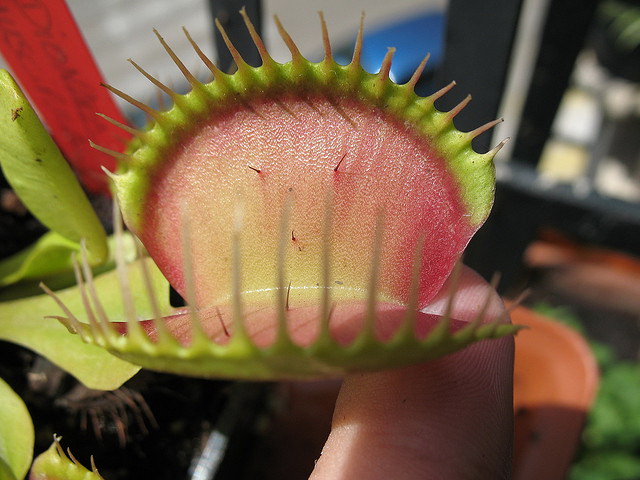
Dionea grows very slowly. The first time it blooms only at the age of 4-7 years. And the flycatcher lives very long - up to 20-30 years.
Origin
Dionei's homeland is North America: Georgia, Florida, North and South Carolina.
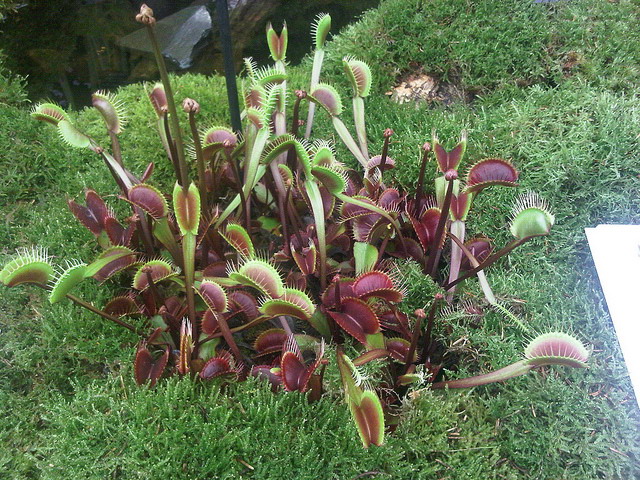
Venus flytrap inhabits pine savanna on peaty, sandy soils in conditions of fairly constant humidity.
All over the world there is a very large demand for carnivorous plants. Currently, the illegal export of a large number of Venus flytraps to Europe causes significant damage to the plant population at home; for example, it is known that in 1993 about 500,000 plants were exported. The second threat to the survival of the flycatcher is the destruction of its habitat.
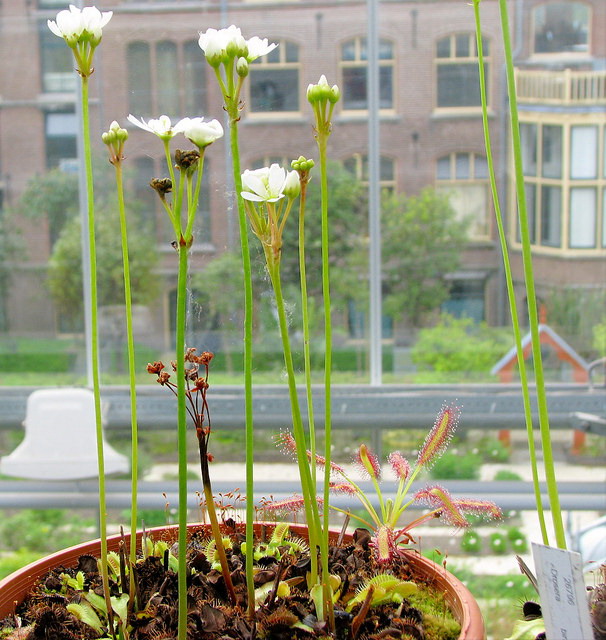
In this regard, the Venus flytrap is listed in Appendix II of the Convention on International Trade in Endangered Species (CITES), which restricts international trade in wild plants of this species. In addition, the law of the United States of its collection in nature is prohibited. In order to fill the necessary demand for a dyon, at the present time, to obtain new specimens, the method of tissue cultures is used. However, experienced growers claim that plants grown by the meristem path are very weak, namely, they constitute the bulk of the items sold in the store. Therefore, so often purchased store flytraps look, to put it mildly, unattractive, especially given the stress they experienced during the long transport. Unfortunately, often these plants die quickly. Dionei derived from seeds are much more resistant.
Bloom
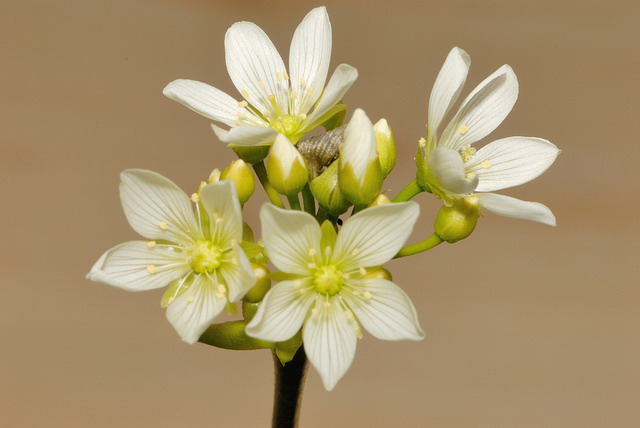
Dionea blooms starting around May. Its flower has a fairly high stem, even up to 60 cm long. It is provided by nature to ensure that insects pollinating a flower do not accidentally fall into the trap that is located below. Only very strong acclimatized plants should bloom, in weak flycatchers it is better to remove flowers, especially if you have just bought a plant in a store.
It is not yet known what mechanism of pollination is dominant: self-pollination or cross-pollination.
Lighting
Dionea is a small plant with a size of no more than 12 cm. Its peculiarity is modified leaf areas - traps, with the help of which the flycatcher catches and digests insects.
The most important condition for the normal growth of Dionei and one of the most difficult attainable factors for its growth is the need to maintain a very high level of illumination. Best of all, summer season will grow outdoors, otherwise it would be advisable to place it on the balcony on the south side. Here and the light will be enough, and the plant can get insects on their own.
Dionee requires at least 4-6 hours of direct sun daily, the rest of the day the plant should receive diffused light. If it is not enough, you can use a fluorescent lamp as an additional light, it should be placed at a height of 15-20 cm above the plant. Some sources talk about the possibility of growing Dionei on windows with less light. However, lighting in this case should be more. The fact that the flycatcher lacks light will say the appearance of the plant - its leaves will become wider and shorter: the plant enlarges the leaf blade, trying to catch as much light as possible with it. In addition, only in bright light does the inner part of the traps turn reddish in green-leaved varieties, and bright red in red-leaved varieties. With an insufficient amount of light, the plant, unfortunately, may die.
It is important that when growing a flytrap it should not be rotated.
A lot of difficulties are associated with irrigation of the flycatcher. The fact is that ordinary tap water is not suitable for Dionei, boiled water and even passing through a normal filter will not work either. The only option is distilled water and water obtained as a result of filtration using reverse osmosis. The fact is that the water for irrigation should not contain any additional impurities that are deadly to the flycatcher.
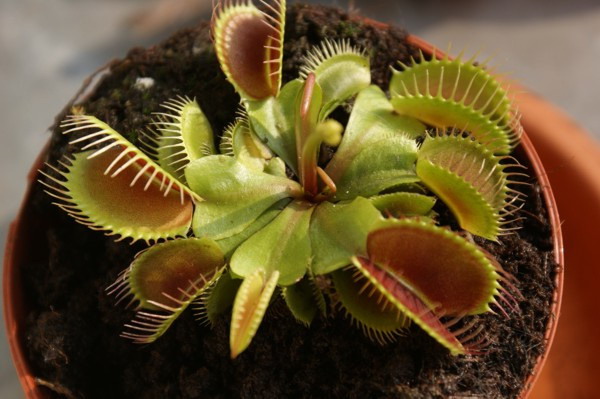
Flycatcher in a pot
Distilled water can be purchased at pharmacies or in some auto shops. You can also ask her from someone you know who are working in a chemical laboratory.
It is best to water the flycatcher from the pan. It should not be watered too much, the moisture should not stagnate in the pot. Although the soil should be wet all the time, it’s not wet.
The more light, the more water is required. For 15 cm (diameter) pots when grown in bright sunshine, the water in the tray should be a little more than 1 cm. For 10 cm pots, the water level in the tray should be about 0.5 cm when stored in bright sunlight. For flycatchers reared indoors, it is usually better if the water in the sump dries out a day or two before watering. If the flycatcher is not grown in full sun, you should be careful that it is not flooded, which can cause the plant to rot. In low light conditions, keep the soil just wet, there should be no water in the pan.
Fertilizer
Under no circumstances should you ever fertilize Dionea. The only way to get nutrients from it is to eat insects. Immediately it should be said that the Venus flytrap "dines" infrequently. If it grows on the balcony, then the owners, in general, do not worry about feeding it: Dione will easily catch the necessary number of insects by herself. Also, do not worry about feeding the plants in the winter: at this time, the dyonya in dormancy does not need insects, since the end of September it cannot be fed.
Anyway, for the whole summer the plant should consume no more than two or three insects. It is not necessary to feed Dionea with worms, from which her traps can begin to rot. In general, the size of the insect should be 2-2.5 times smaller than the size of the trap. Otherwise, the insect will not be able to digest and will rot along with the trap.
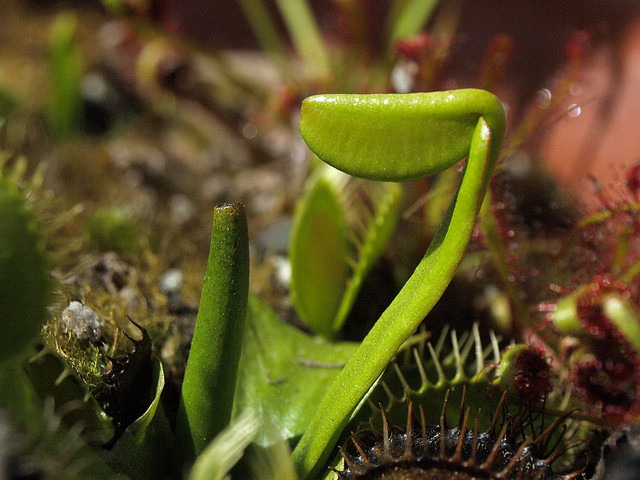
Development of a new leaflet with a trap in the spring
Despite the above video, insects for feeding must be alive. First, the trap will shut only if an insect hits 2 sensitive hairs inside it. Secondly, the secretion of digestive enzymes will begin only if the animal caught in the trap moves inside the trap. Otherwise, after a while the trap may reopen. This mechanism is directed against its idle work in nature in the event that some speck of dust or a knot falls into the trap. Perhaps such cruelty towards insects is not very popular with some sensitive natures, but, unfortunately, in nature, including in the plant world, there is no idea of good and evil. By the way, for most lovers of carnivorous plants, the process of feeding them is of the greatest interest and is of particular joy.

The trap is shut!
Usually insect digestion lasts about 10 days, after which the trap opens, and only the chitinous integument of the animal remains in it. It should be remembered that each trap is designed to digest only three insects, then it dies. Therefore, no matter how desirable, do not annoy the trap, artificially causing it to slam. Feed the traps should take turns, it is better to use the older ones first. The most important thing is not to use dead insects and not to overfeed! A trap that starts to blacken should be carefully removed in a timely manner.
Rest period
One of the most common causes of plant death with room maintenance is the absence of a dormant period in the winter for 3-4 months. For normal growth of the Venus flytrap must necessarily be contained in winter at low temperatures. Since September, due to the decrease in the length of the day, the plant will independently begin to move to rest, which will be noticeable on shorter and wider leaves. When there comes a period of rest, the growth of Dionei stops. During the winter months, the flycatcher is best kept on a warmed loggia, so that the temperature does not fall below + 0-10 0 C. Substrate should be moistened periodically with water of the same temperature as the air temperature. In general, Dionea can withstand even sub-zero temperatures, but inexperienced gardeners should not try to carry out such dangerous experiments on their plants. During hibernation in the cold lighting should not be strong. Sometimes the aboveground part of the flycatcher even dies off, but do not immediately throw away the plant. The main thing is that white bulbous stems remain in the ground. In February, Dionea is transplanted and exposed to light, as soon as it begins to grow, they increase irrigation.
For those who do not have a warmed loggia, the only way out of the winter maintenance of a flycatcher will be to store it in a refrigerator at a temperature of about +5 0 C. Dioneu is kept on a cool balcony during October, then sprayed with a fungicide and placed in a refrigerator, covered with a bag. During the winter, the substrate of the plant in the fridge is moistened several times. In the spring the flycatcher is transplanted into a new substrate. You can also cut the leaves and store in the refrigerator only one bulb, occasionally moistening them.
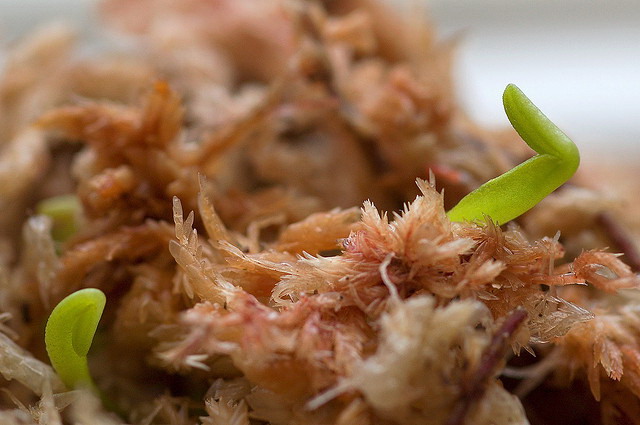
Flycatcher germinates after wintering
There is another way of keeping Dionei in winter: in early December, shake the plant out of the soil, clean the roots of the substrate with water. At the same time, it is desirable to remove black and rotten parts of plants. Then put the flycatcher between the layers of sphagnum, which should be pre-sprayed with a fungicide. Then the saucer is covered with a plant and sphagnum with polyethylene, the saucer is turned over, the sphagnum is completely wrapped in polyethylene and the package is placed in a refrigerator. Get the plants around the beginning of March. Sometimes in spring the leaves of some plants that were wintered according to the latter method are folded down. Such leaves should be removed before planting the plant.
Humidity
Humidity is not a very important parameter for growing Dionei. It can carry quite dry air. Although in stores quite often the plant is sold in transparent caps, at home they should be removed and the flycatcher grown in the open air. The content of dionei in the terrarium, on the contrary, can contribute to the very rapid death of the plant.
Temperature
In summer, the plant requires a normal room temperature of + 16-24 ° C, although in the opinion of most gardeners, Dione perfectly adapts to heat (up to +35 0 C) and to cold in winter (even to sub-zero temperatures).
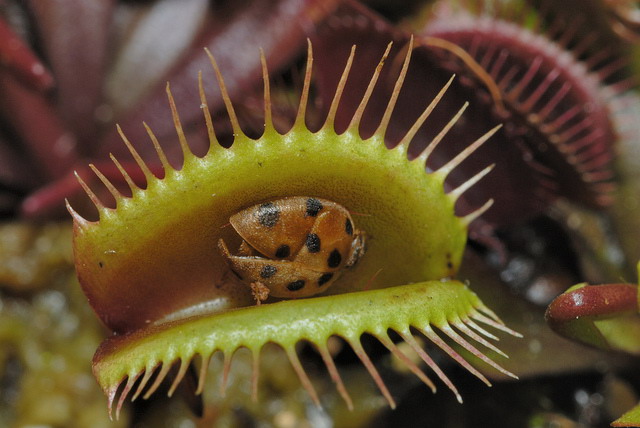
Substrate
Very strict requirements are imposed on the substrate for growing Dionei, since Properly selected substrate is one of the main conditions for its successful cultivation. Under no circumstances would normal soil be suitable for the flycatcher. The most important condition is that the soil should be inert and not contain any mineral components. It is on such poor substrates that Dionea grows in nature. It receives any nutrients from the insects eaten, and in the soil they can kill it.
You can only use special high-moor peat, on the package with which it is written that it is “not sour” (pH 2.8-4). Usually peat is mixed with either perlite or quartz sand in a 1: 1 or 2: 1 ratio. Regular sand can not be used, use only a special quartz, which can be found, for example, in some pet stores. Regarding sphagnum there is no single point of view: some gardeners prefer not to use it for growing flycatchers, others suggest mixing sphagnum with perlite in a 1: 1 ratio and successfully apply such a mixture. It is advisable to soak perlite for the substrate in distilled water and boil it in order to get rid of its possible salinity.
Transfer
The flycatcher should be transplanted every year or after a year. It should be noted that after buying in the store the plant is also desirable to transplant, because Most likely, the plant in the store was watered by not distilled water, so the substrate at the time of purchase of the dionei may already be quite saline. However, some lovers managed to grow Dionea in the store substrate during the year. Apparently, these people were lucky: the plant got to them, bypassing the long stage of store maintenance.
Usually small pots about 8 cm in diameter and 10 cm tall are used for the plant. When transplanting shake off all the old soil. Drainage in the pot is not needed. A hole is made in the substrate (preferably with the back of tweezers) and the lower part of the flycatcher is placed in the hole so that the entire lower white part of the plant is submerged in the soil and slightly green. Then pour the substrate around the plant. You can make a small hill around it, which is then easily washed away with water when watering. The soil does not need to be compacted.
It is very important when transplanting not to touch the traps, in order to avoid their spontaneous idle actuation.
Difficulties
If the humidity level is too high, fungal infections may occur.
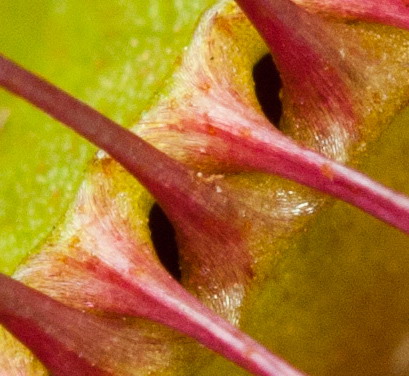
Closed "teeth" trap Dionei
Among the most dangerous pests include aphids. In this case, the leaves of the plant bend, twist, become ugly. It is also possible defeat spider mites. With excessive humidity and cold, dionya can rot. Sometimes traps start to rot if a too large animal gets into them.
Breeding
The most common breeding method for flycatchers is plant division during transplantation. Over time, the plant grows and forms many daughter bushes, and they can be separated for the purpose of reproduction. Of course, the young plant must have its own roots, and the cuts must be powdered with crushed coal. However, it is not necessary to get involved in these processes too, because Dionea grows better, forming large "colonies".
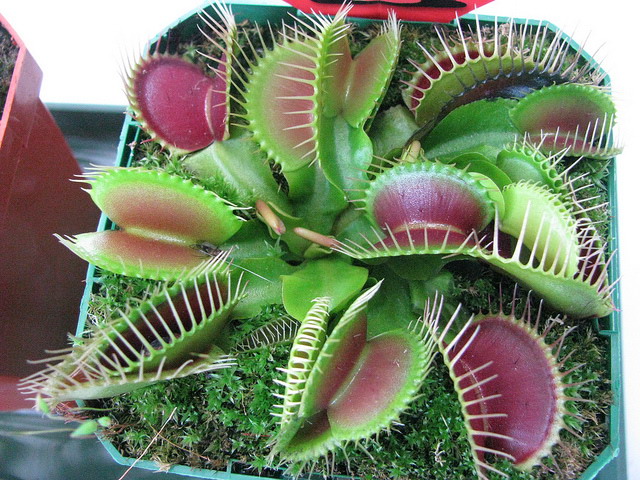
The trap is shut!
Seed multiplication is often used, but it is worth emphasizing here that flycatcher seeds lose their germination very quickly. Therefore, it is better to get the seeds yourself during the flowering of the plant. To do this, transfer pollen with a brush from stamens to pistil. After that it is necessary to sow the seeds for 2-3 days. If the seeds have been stored longer, then they require stratification.
In this case, the seeds should be stored in a refrigerator for 6 weeks before sowing. It is better to keep seeds in a wet, airtight state by placing them in a sphagnum and zap-lock in a special bag. You can also wrap the seeds with a damp paper napkin, put a paper towel in a plastic bag, and then put it in the refrigerator. Treating seeds with gibberellic acid is a much faster method; however, it is difficult to find and expensive. Fresh or stratified seeds are sown on the soil surface; they should not be sprinkled on top of them with the substrate. Humidity is best maintained at 40 - 50%. If desired, you can sow them in pots, which cover the top with glass to maintain moisture. The container is placed on a bright light or under fluorescent lamps with a light duration of about 16 hours / day. Within one - a few months they must germinate. To prevent fungal infections, fungicides are used. As a few leaves and roots are formed, the plants are deposited, but care should be taken not to damage the tiny roots. An adult plant is formed from a seed only in 5-7 years.
Seed germination is very interesting. First, cotyledon leaves that do not have traps appear, but the next leaves will already have very small traps of a few millimeters in size. Every year the size of traps increases about 2 times.
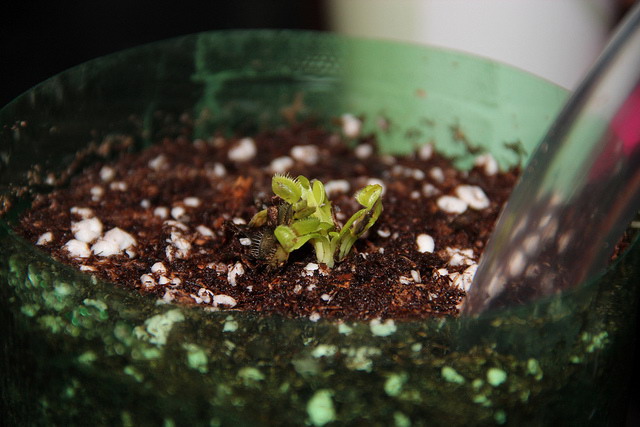
Flycatcher breeding is sometimes used with leaf cuttings. Pinch off a leaf from a plant so that the stalk contains the white part. If the cut was uneven, level it with a sharp blade. Handle the cut root. Then put the cutting at an angle into the substrate of peat with perlite or of peat with quartz sand. It is best for germination to use a transparent plastic container, which is covered with a lid to maintain moisture. Place the container on a bright light and wait until growth occurs at the base of the cuttings. This process can be quite lengthy, up to 3 months. Very often, the cuttings rot or are affected by the fungus.
If on vacation
The Flycatcher is a plant that is gentle enough, so it's best not to leave it unattended when going on vacation.
Used photos from flickr.com.
One of the most unusual plants for growing at home is the flycatcher flower. A photo of such an attractive carnivorous predator, which has a small size and is equipped with traps with two flaps and thin hairs at the edges, displays the moment of waiting for a potential victim. As soon as the latter inadvertently descends on a charming plant, the trap immediately slams and reincarnates into the stomach, where digestion of careless prey occurs, which can last more than 10 days. Saturated to the full, the Venus flower of the flycatcher again friendly opens its doors in anticipation of a new victim.
Such an unusual flower was discovered at the end of the 18th century and named Dionea (in honor of the Greek goddess). The name of the species muscipula from Latin is translated as "mousetrap".
Flycatcher Flowers: Care
Venus Flytrap, whose birthplace is America, is a hardened and optimally adapted for seasonal fluctuations in flower temperatures. Rather unpretentious care flowers of the flycatcher do not tolerate stagnant air, needing regular airing of the room in which they are located. The plant, negatively related to the shade, comfortably feels on the east and west sides of the room, characterized by a softer light penetration. The lack of sunlight can be determined by the dull color of the traps and leaves that have become elongated and thin.
As a soil for such an unusual culture is required to use sand and peat soil; in order to avoid its drying, which should not be allowed, it is recommended to lay out moss on top. A pot with a plant must be provided with a pallet with a supply of rain or purified water. Tap water due to the content of a large number of additional compounds can be disastrous for the flower.
Flycatcher Flowers: Feeding
As feed, which is just as important for the plant as sunlight, the Venus flytrap, which has successfully adapted to growth at home, prefers fresh, soft larvae of a small size. The large size of the prey can provoke incomplete slamming of the trap, as a consequence of its rotting. And from this, in turn, the flycatcher flower can die. The photo below shows the fragile and at the same time tempting structure of the trap.
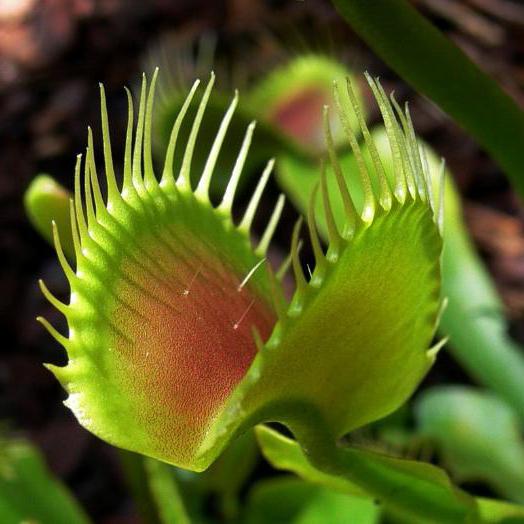
Venus flytrap meat should not be given, as well as to overfeed the plant, in order to prevent its death. Feeding a flower is required to produce no more than once every 7-10 days and to feed one or two traps, no more. The prey must be alive and moving, thus irritating the hairs - triggers, very sensitive to any, even the slightest movement. As soon as the hairs are in contact with each other, the trap closes and opens after about 10 days, when the food is completely digested. Despite the fact that the plant is carnivorous, it is able to do without living food for a period of time: a month or two.
Rest period: features of care
For hibernation, a sign of which is the cessation of the growth of new foliage, the Venus flytrap begins to prepare in the fall. At this time, the plant requires a minimum amount of moisture, so the water from the pan can be poured, but the condition of the soil in any case is required to control, preventing it from drying out.
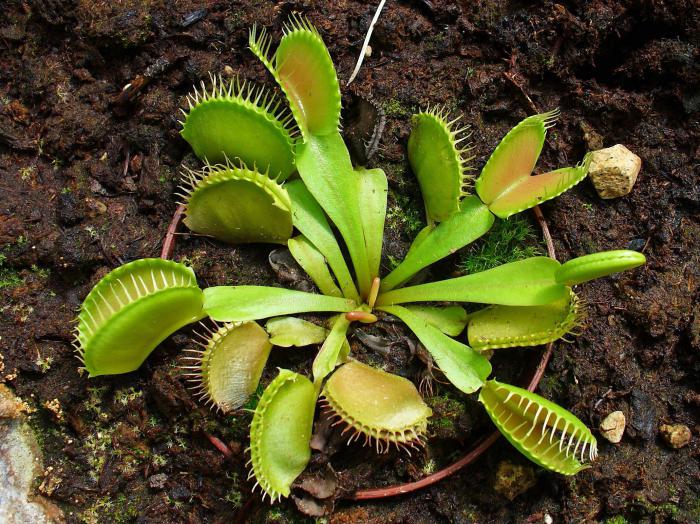
In winter, flycatcher flowers are recommended to be placed in a cooler (with a temperature of 2 to 10 degrees Celsius) and a darkened place, because at this time the plant does not need lighting. A sleeping flower, in the period of rest almost not eating insects, is not very attractive in appearance. When you look at him during the rest period, which lasts from November to February, you might think that he was dead: the leaves turn brown and die, the growth stops. Many flower growers, mistaken in this way, are thrown away. In fact, it is required to just cut off the dead parts of the plant (traps and leaves) and keep the soil in which it grows in a moderately moist state.
Venus flytrap: transplant
When spring comes, the flycatcher flower (the photo in the article demonstrates it from different angles), whose active growth begins at the end of May, can be returned to its usual place and transplanted. Venus flytrap transplants can be transplanted throughout the year, but the most optimal period for this is spring. Since the root system of the flycatcher grows deep down, it is recommended to select a deep narrow pot.
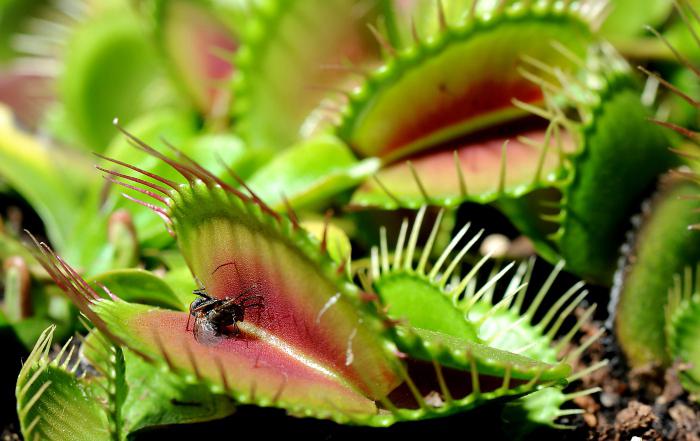
When transplanting, which is required to be done very carefully due to the fragility of the roots, several children can be immediately separated from the mother plant and planted as an independent flower culture. Before transplanting the roots, it is recommended to soak in water for a few minutes in order to remove the remnants of the old soil. The plant will get used to the soil for 5 weeks, therefore during this period it is recommended to have abundant watering and moderate sunlight.
Pests and diseases
Flytrap flowers dangerous for insects can sometimes become victims of pests, the most harmful of which are aphids, mealybugs and spider mites. In order to avoid damage to the plant, preventive measures are required, namely treatment with insecticidal aerosols throughout the year. Strong overmoistening of the soil can cause the appearance of fungal diseases, which can be eliminated by treating the plant with a fungicide.
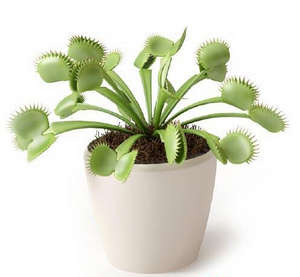
Venus flytrap ( lat Dionaea muscipula) - this is a unique predator plant from the family Droseraceae (Rosyanka), belongs to the same genus Dionea.
The plant got such an interesting name in honor of Venus, the goddess of love ( in English. - Flytrap Venus), and the scientific name of the flycatcher literally translated from Latin means " mousetrap of venus". It is believed that such a name is a botanist scientist gave the plant by mistake, since the Venus flytrap is a predatory plant that can be grown at home - but it means that for one food it is not enough moisture, but she does not catch mice. But flies plant catches and "eats." As for Venus, the botanist was in search of floristic artifacts for so long that in every plant he saw, let's say, a woman in different incarnations. This is how this strange, but intriguing name appeared.
 The flower grows mainly in the Atlantic coast of America (New Jersey, South and North Carolina, Florida), where the pronounced humid temperate climate. The Venus flytrap looks like a grassy undersized plant with a rosette of leaves (from 4 to 7 pieces) growing from an underground short stem. The size of the VM is small - up to a maximum of 20 cm in nature, in home cultivation - about 10-12 cm. The leaves of the flower with teeth are quite long and, depending on the season, can reach 7 cm in length and 2-3 cm in height. They play the role of a trap and are formed only after flowering. The traps are colored from pink to dark red, depending on the age of the plant.
The flower grows mainly in the Atlantic coast of America (New Jersey, South and North Carolina, Florida), where the pronounced humid temperate climate. The Venus flytrap looks like a grassy undersized plant with a rosette of leaves (from 4 to 7 pieces) growing from an underground short stem. The size of the VM is small - up to a maximum of 20 cm in nature, in home cultivation - about 10-12 cm. The leaves of the flower with teeth are quite long and, depending on the season, can reach 7 cm in length and 2-3 cm in height. They play the role of a trap and are formed only after flowering. The traps are colored from pink to dark red, depending on the age of the plant.
The flycatcher feeds mainly on small insects, spiders, and sometimes clams — in general, everything that crawls or flies into the trap itself.
The mechanism for capturing prey from Venus flytrap directly depends on the interaction between size, elasticity and turgor of the leaf. When the plant is open, parts of the sheet are bent outwards, in the closed state, on the contrary, the sheet is bent inwards, thereby forming a cavity, the entrance to which is closed by "cilia". When the "cilia" are stimulated by the movement of calcium ions, an electrical impulse appears, which, spreading over the entire leaf of the flower, stimulates the cells in the midline of the leaf and the lobes.
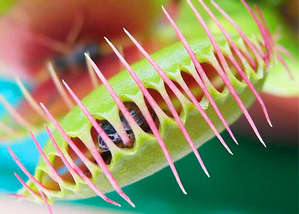 If the insect could not escape from the trap, it stimulates the inner wall of the leaf blade, which leads to a rapid growth of cells. Ultimately, the leaf edges are completely closed, a kind of “stomach” is formed, in which the prey is digested by extracting the juice. Digestion can last up to ten days, then nothing is left of the prey except for the empty chitinous shell. Further, the trap opens again, and this means readiness to seize new prey.
If the insect could not escape from the trap, it stimulates the inner wall of the leaf blade, which leads to a rapid growth of cells. Ultimately, the leaf edges are completely closed, a kind of “stomach” is formed, in which the prey is digested by extracting the juice. Digestion can last up to ten days, then nothing is left of the prey except for the empty chitinous shell. Further, the trap opens again, and this means readiness to seize new prey.
How to grow a Venus flytrap at home
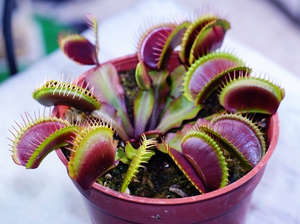 Interestingly, this predatory flower grows well, both in wild conditions and in conditions of decorative gardening. Moreover, it is possible to grow Venus flytrap at home, however, this requires careful maintenance, especially it is necessary to monitor the level of humidity in the room during the winter season, when the heaters dry the air.
Interestingly, this predatory flower grows well, both in wild conditions and in conditions of decorative gardening. Moreover, it is possible to grow Venus flytrap at home, however, this requires careful maintenance, especially it is necessary to monitor the level of humidity in the room during the winter season, when the heaters dry the air.
This is not to say that the Venus flytrap for growing at home is a capricious plant. Since its natural habitat is the coast of the Atlantic Ocean, the plant is accustomed to seasonal temperature changes. Under natural conditions, even with the first frosts and snowfall, the Venus flytrap does not die, but the flower cannot withstand strong and prolonged frosts. In winter, at home, the plant leaves the bottom rosette of leaves, that is, the ground part, which the plant feeds on, dies.
Until the very spring, the V. flycatcher is at rest, but with the first heat and sunlight the plant begins to lead its predatory lifestyle.
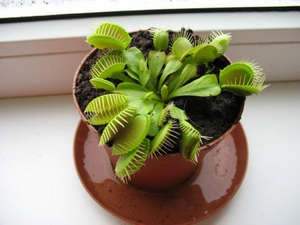 Underground short stem - the onion begins to be poured with juice, a rosette of seven leaves appears, each of which can reach up to 10 centimeters. Leaves sprout alternately, one above the other, according to the "number of floors" principle. Along with the first leaves, stalks appear, on which rather beautiful white flowers bloom. And only after that, when the plant fades, the leaves transform into a trap. This is the main information from the field of botany, which you need to know to flower growers who like exotics.
Underground short stem - the onion begins to be poured with juice, a rosette of seven leaves appears, each of which can reach up to 10 centimeters. Leaves sprout alternately, one above the other, according to the "number of floors" principle. Along with the first leaves, stalks appear, on which rather beautiful white flowers bloom. And only after that, when the plant fades, the leaves transform into a trap. This is the main information from the field of botany, which you need to know to flower growers who like exotics.
He is building to say that now this exotic plant is increasingly beginning to grow at home. Grow a flower can both in the apartment on the windowsill and in the garden.
Care for Venus flytrap is quite simple, but you need to remember about some features.
In order for the flower to feel comfortable at home, you need to follow one of the main rules of care, namely, imitation of natural conditions:
- sufficient humidity - there must always be water in the pan (except for the rest period);
- sand and peat ground - the land from the garden is not suitable for growing this plant because of its acidity;
- good level of lighting, but not on the south side, or light shading.
![]() Although the plant is light-loving, it does not tolerate stagnant hot air, so regular airing is necessary. In general, if you want your flycatcher to feel comfortable in your home, the care is simple - keep it on the sunny side, open windows more often and use air conditioners that moisturize the air whenever possible. In winter, do not put the pot next to the heaters.
Although the plant is light-loving, it does not tolerate stagnant hot air, so regular airing is necessary. In general, if you want your flycatcher to feel comfortable in your home, the care is simple - keep it on the sunny side, open windows more often and use air conditioners that moisturize the air whenever possible. In winter, do not put the pot next to the heaters.
For proper care, keep the Venus flytrap in a pot on a tray with a supply of clean or rain water - because the plant loves wetlands in nature.
The soil should not be overdried, so it is recommended to put moss on top of it.
How to feed a predatory plant?
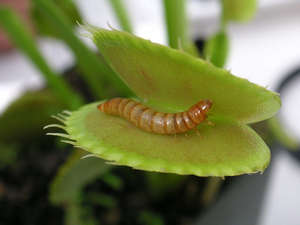 Feeding is one of the important aspects of proper care for this strange flower at home. Insects (mosquitoes, larvae, flies, small slugs, worms) for feed should be soft and small in size. If the food is not digested by the plant to the end, the trap can rot. Categorically you can not feed the plant meat in any form. At the end of autumn the flycatcher is prepared for hibernation - you will notice this by stopping the growth of the leaves.
Feeding is one of the important aspects of proper care for this strange flower at home. Insects (mosquitoes, larvae, flies, small slugs, worms) for feed should be soft and small in size. If the food is not digested by the plant to the end, the trap can rot. Categorically you can not feed the plant meat in any form. At the end of autumn the flycatcher is prepared for hibernation - you will notice this by stopping the growth of the leaves.
During this period, the care of the plant is to reduce the number of irrigations, and, therefore, the water from the pallets must be removed. But the soil still does not have to be over dried.
During the “winter sleep” period, it is advisable to move the Venus flytrap to a cooler and darker place with a temperature of + 10 ° C.
At this time, the flower can be kept in the refrigerator, covered with a plastic bag, or on the glazed balcony. Do not forget about the care even during this period, which is passive for the plant - maintain the desired soil moisture.
By the way, the plant also needs regular fertilizing through the soil - it is necessary to add standard fertilizer for flowering plants to the water for watering once a week, according to the instructions. It is important not to overfeed the plant, from this it can die.
Growing Venus Flytrap in the garden
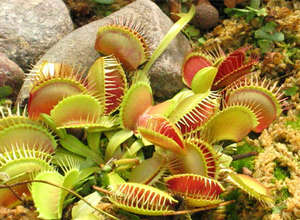 Growing a flower in the conditions of the garden, where the flycatcher itself can provide food, it is not necessary to feed it in addition. But remember the following points of care: the soil must be covered with moss, the size of the box should be more than 30 centimeters in width and 20 centimeters in depth. The box with Venus flytrap can not be kept in direct scorching sunlight.
Growing a flower in the conditions of the garden, where the flycatcher itself can provide food, it is not necessary to feed it in addition. But remember the following points of care: the soil must be covered with moss, the size of the box should be more than 30 centimeters in width and 20 centimeters in depth. The box with Venus flytrap can not be kept in direct scorching sunlight.
As you can see, caring for this unique and exotic flower at home is pretty straightforward.
The main thing is to monitor the soil moisture and lighting, do not feed the plant with prohibited foods.
If several elementary rules are observed, an amazing exot will delight you with its bright appearance for a long time. And, besides, given the reflex reactions of Venus flytrap, you can more acutely feel moments of communication with this amazing plant.
